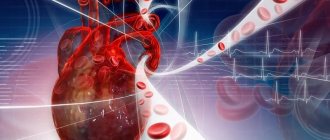Pericarditis is inflammation of the outer lining of the heart. Most often it is infectious, rheumatic or post-infarction. Pericarditis has the following symptoms:
- Weakness;
- Constant pain behind the sternum, which intensifies when inhaling;
- Cough;
- Severe shortness of breath.
Pericarditis occurs with fluid leaking between the pericardial layers (observed with exudative pericarditis). This pathology is dangerous due to the development of suppuration and cardiac tamponade (when accumulated fluid compresses the heart and blood vessels) and may require immediate surgical intervention.
Pericarditis can be a symptom of a systemic, infectious, cardiac disease, as well as a complication of various pathologies of internal organs or injuries. Often it is pericarditis that becomes of paramount importance in the clinical picture of the disease, and other manifestations of pathology fade into the background. Diagnosis of pericarditis is not always made while the patient is alive; in approximately 4–7% of cases, signs of past pathology are determined only at autopsy. Pericarditis can occur at any age, but, as a rule, occurs among the adult and elderly population, and the incidence of pericarditis in females is higher than in males.
With serous pericarditis, the inflammatory process spreads to the serous tissue membrane of the heart (parietal, visceral plate and pericardial cavity). Permeability increases and blood vessels dilate, leukocytes infiltrate, fibrin is deposited, adhesions are added and scars are formed, pericardial layers become calcified and the heart is compressed.
Pericarditis has the following causes:
- Rheumatism (endocarditis and myocarditis are also affected);
- Tuberculosis (when infection spreads from foci in the lungs through the lymphatic ducts to the lymph nodes.)
Both diseases are manifestations of an infectious-allergic process.
Certain conditions increase the risk of developing pericarditis, including:
- Infectious and viral diseases - influenza, measles;
- Bacterial processes - tuberculosis, tonsillitis, scarlet fever;
- Sepsis;
- Fungal and parasitic infection;
- Pneumonia;
- Pleurisy;
- Endocarditis (lymphogenous or hematogenous route);
- Allergic damage (serum sickness, drug allergy);
- Systemic connective tissue diseases (lupus erythematosus, rheumatoid arthritis, rheumatism and others);
- Heart pathologies (myocardial infarction, endocarditis or myocarditis);
- Surgical interventions;
- Malignant processes;
- Metabolic disorders (toxic effects due to uremia and gout);
- Radiation damage;
- Heart malformations (pericardial cysts and diverticula);
- Edema;
- Hemodynamic disturbances (as a result, fluid accumulates in the pericardial space).
At the Yusupov Hospital, patients with pericarditis are provided with all types of treatment by highly qualified doctors. Specialists collect all anamnestic data in detail and conduct diagnostic studies using the latest equipment. The staff of the Yusupov Hospital takes care of their clients not only in a hospital setting, so patients with pericarditis are given precise clinical recommendations after discharge.
Why does pericarditis occur?
The following are the main causes of pericarditis:
- Infectious agents: viruses, bacteria, fungi and even parasites. The inflammatory process in the pericardium is triggered by the influence of exo- and endotoxins released by microorganisms.
- Autoimmune connective tissue diseases such as lupus erythematosus or scleroderma. At the same time, the body synthesizes antibodies to its own cells, which damage connective tissue and cause systemic inflammation.
- Heart diseases. The result of serious damage to the heart muscle is the spread of the pathological process to the surrounding pericardium. This can occur with transmural myocardial infarction, infectious or reactive myocarditis.
- Damage to other organs, such as the kidneys, can lead to pericarditis. In cases of serious impairment of excretory function and the formation of renal failure, deposition of metabolic products in the serous cavities, including the pleura and pericardium, is observed.
- Penetrating pericardial injuries that disrupt the integrity of the pericardial layers.
- Metastatic tumors that cause pericardial carcinomatosis.
- The causes of pericarditis are varied, and, therefore, treatment approaches depend on what caused the inflammation. But in the absence of timely diagnosis and correction of this condition, the outcome is always the same. The result of chronic pericarditis is cardiac tamponade, which leads to the death of the patient.
At CELT you can consult a cardiologist.
- Initial consultation – 3,500
- Repeated consultation – 2,300
Make an appointment
Classification of pericarditis
There are primary and secondary pericarditis. The disease can be limited, occupying the base of the heart, partial, or general diffuse (the entire serous membrane is involved).
Considering clinical data, pericarditis can be acute or chronic.
Acute pericarditis develops quickly, lasting no more than six months, among them there are:
- Fibrinous pericarditis (dry);
- Exudative;
- Serous-fibrinous pericarditis;
- Hemorrhagic;
- Purulent;
- With and without cardiac tamponade.
Chronic pericarditis develops slowly, lasts more than six months and is divided into:
- Effusion pericarditis;
- Adhesive;
- Exudative-adhesive;
- Asymptomatic;
- Pericarditis with functional disorders of cardiac activity;
- Pericarditis with extracardial adhesions;
- Constrictive;
- Pericarditis with dissemination of inflammatory granulomas.
Non-inflammatory pericarditis includes:
- Hydropericardium;
- Hemopericardium;
- Chylopericardium;
- Pneumopericardium;
- Effusion due to myxedema, uremia, gout.
Pericardial neoplasms include:
- Primary tumors (benign and malignant);
- Secondary;
- Paraneoplastic syndrome.
Among the rare diseases of the pericardium, pericardial and coelomic cysts are distinguished separately. Such cysts can be congenital or acquired.
What are the types of pericarditis?
According to the pathophysiological mechanism, pericarditis is divided into:
- exudative pericarditis (when inflammatory fluid accumulates in the cavity - exudate);
- adhesive pericarditis (when “dry” inflammation predominates and adhesions form);
- constrictive pericarditis (when compression of the heart occurs and calcification of the pericardial walls).
This division is very arbitrary, because at different stages of the pathological process the type of inflammation can transform. And the formation of areas of calcification is the outcome of any pericarditis in the absence of adequate therapy.
Types of disease
The clinical picture and course of the disease depends on the underlying disease.
- Nonspecific pericarditis is often accompanied by frequent relapses. The most common cause of its occurrence is complications after viral infections or radiation. Occurs after a viral infection of the upper respiratory tract, insolation. Without timely treatment, it can develop into an exudative or constrictive form.
- With purulent pericarditis, hardware or puncture examination reveals a moderate accumulation of pus in the heart sac.
- Rheumatic pericarditis is a sign of active rheumatism and often occurs against the background of inflammation of the walls of the heart - rheumatic carditis.
- Metastatic pericarditis may be the first sign of lung or breast cancer. A primary pericardial tumor that also causes pericarditis, mesothelioma, is rare.
Symptoms of pericarditis
The onset of pericarditis, symptoms and first signs are quite characteristic. The main reason to see a doctor is chest pain. The pain syndrome in this disease can be quite pronounced and persistent. But there are times when fever comes first in severity. Its combination with shortness of breath and chest pain is often mistaken for pneumonia.
The pain syndrome in this cardiac pathology can radiate, as with angina pectoris, to the left arm and shoulder blade. But the hallmark of pain with pericarditis is the lack of connection with physical activity. The pain is almost constant and intensifies when changing body position or taking a deep breath.
In addition to pain, pericarditis is always accompanied by additional symptoms: general weakness, increased body temperature, shortness of breath with little physical exertion, interruptions in heart function, and decreased blood pressure. Unlike angina, nitrate-based medications do not provide relief.
If you notice similar symptoms in yourself or your loved ones, you need to urgently consult a doctor, because the price of delay can be human life. Only a professional cardiologist, having examined the patient and prescribed an immediate instrumental examination, will be able to accurately diagnose and recommend adequate treatment.
Otherwise, if medications are not prescribed in a timely manner, a terrible complication inevitably arises - cardiac tamponade. With tamponade, a large amount of exudate accumulates in the pericardial cavity. The consequence is that the heart muscle is literally compressed and cannot fully contract.
The result of such compression is acute cardiovascular failure, cardiac arrest and death of the patient. In this case, the usual methods of resuscitation rarely have a positive effect, and only the release of the pericardium from the excess amount of exudative fluid can make the heart beat again.
Treatment
Most patients with acute pericarditis have a good long-term prognosis.
- Anti-inflammatory drugs.
- Immunosuppressive and biological therapy.
- Glucocorticoids.
- Diuretics - for large amounts of effusion.
Treatment will be different for pericarditis of different etiologies. Bacterial pericarditis is treated with antibiotics. If the pathology has a tumor cause, then cytostatics are used; uremic pericarditis requires hemodialysis. In difficult cases, surgery may be required to remove part of the pericardium.
Prices for services
| Name | Time | Price | |
| Appointment with a cardiologist, treatment and diagnostic, primary, outpatient | 1500 | ||
| Treatment and diagnostic appointment with a cardiologist, repeated, outpatient | 1000 | ||
| Preventive, outpatient appointment with a cardiologist | 550 | ||
| Holter ECG recorder with Holter data decoding | 3250 | ||
| Comprehensive consultation with a cardiologist ECG with interpretation + Echo-kg | 3650 | ||
| Call a doctor to your home (Khimki, Starbeevo, Ivakino, Naberezhnye) | 15000 | ||
| Calling a doctor to your home (Skhodnya, Podrezkovo, Novopodrezkovo, Planernaya station, Firsanovka) | 15000 | ||
| Call a doctor to your home (Kurkino, Novogorsk) | 15000 | ||
| Call a doctor to your home (Left Bank, Moscow, within the Moscow Ring Road) | 15000 | ||
| MRI of the thoracic spine. | 4500 | ||
| Medical consultation | 3300 | ||
| Extract from outpatient card | 660 | ||
| Consultation (interpretation) with analyzes from third parties | 1300 | ||
| Consultation on treatment adjustments | 550 | ||
| Repeated reception of CMN | 1600 | ||
| Initial reception of CMN | 2000 | ||
| Express test for determining the level of Troponin in the blood. | 1900 | ||
| Expand all prices | |||
Treatment of pericarditis
The following groups of drugs are used in the treatment of pericarditis:
- Non-steroidal anti-inflammatory drugs that relieve the symptoms of inflammation.
- Antibiotics, antiviral, antifungal and antiparasitic drugs, if the etiological factor is an infectious agent.
- Glucocorticosteroids and cytostatics, if the cause of pericarditis is an autoimmune pathology.
- Treatment of the underlying disease that caused pericarditis - in case of renal failure, hemodialysis can be used, and in case of myocardial infarction - thrombolysis and restoration of blood flow through the coronary arteries.
- If there is a threat of developing cardiac tamponade, they resort to puncture of the pericardial cavity. The purpose of this manipulation is to remove fluid and prevent tamponade. But this puncture is no less important in diagnostic terms. The resulting exudate is subjected to microscopy, bacteriological and cytological examination. It can contain atypical tumor cells or an infectious pathogen.
The prognosis for pericarditis is generally favorable. If pericarditis is correctly diagnosed and treatment is started on time, then a complication in the form of tamponade is extremely unlikely. But it is worth remembering that pericarditis, the treatment of which requires a professional approach, is a rather formidable disease with dangerous complications.
By contacting CELT cardiologists, you can be absolutely sure of timely diagnosis and correct treatment tactics for any cardiac pathology. After all, we employ specialists of the highest category with extensive practical experience. Another argument in favor of CELT is that our clinic has the technical capabilities for a full and comprehensive examination.
Make an appointment through the application or by calling +7 +7 We work every day:
- Monday—Friday: 8.00—20.00
- Saturday: 8.00–18.00
- Sunday is a day off
The nearest metro and MCC stations to the clinic:
- Highway of Enthusiasts or Perovo
- Partisan
- Enthusiast Highway
Driving directions
Reasons for the development of the disease
This cardiac disease has a polyetiological nature:
- Infectious causes include rheumatic, tuberculous, bacterial. In addition, pericarditis can have a fungal or viral etiology, for example, with influenza.
- Aseptic reasons include allergies, diffuse connective tissue diseases, hematological diseases, malignant processes, injuries, radiation exposure, hypovitaminosis.
- Idiopathic pericarditis may also develop, the cause of which cannot be determined. It is these pathologies that are most often prone to relapse.
Issues of systematization, diagnosis and conservative treatment of pericarditis
Pericarditis is one of the diseases that is not sufficiently described in the literature. Meanwhile, in clinical practice they occur quite often, are difficult to diagnose and differentiate, and require the appointment of various pathogenetic therapies. According to various authors, pericarditis is detected in 4–6% of deaths from all diseases. A prominent domestic specialist in pericardial diseases A.A. Gehrke (1950), in an analysis of 37,161 autopsy reports of those who died from various causes, found acute pericarditis in 1.6% of cases. In recent years, there has been a certain increase in the number of pericarditis, which is apparently due to an increase in the number of viral and systemic connective tissue diseases, the emergence of relatively new etiological factors (radiation injuries, postcardiotomy syndrome, etc.) [1, 4, 8]. Table 1 presents the classification and incidence of pericarditis of various etiologies. One of the prominent experts on the problem of pericardial diseases, DH Spodick (2003) [6], rightly believes: 1) pericarditis can be a manifestation or complication of many diseases; 2) diagnosing pericarditis requires differentiation from a wide range of diseases and complications; 3) instrumental, laboratory and etiological criteria for pericarditis are constantly updated, which requires their use in everyday clinical practice.
Clinical manifestations
Acute pericarditis is divided into dry, fibrinous and exudative.
In the initial period, an increase in body temperature, general weakness, and myalgia may be observed, but there are non-febrile forms. Symptoms are characterized by pain in the chest - behind the sternum, in the left precordial region with possible irradiation to the trapezius muscle. The pain may be pleural in nature, increasing with deep breathing, or resemble angina pectoris, radiating to the left arm and shoulder blade. Shortness of breath may occur at rest and when changing body position. In the presence of pleural effusion - dullness of percussion sound, weakened breathing. Auscultation can detect (not always!) a pericardial friction noise (1-, 2- and 3-phase), and an increase in sinus rhythm is noted. The main clinical symptoms of exudative pericarditis: pale skin, cyanosis of the lips, acrocyanosis; sitting position of the patient with the torso tilted; pulsating, distended jugular veins, positive venous pulse; cardiac and apex beats are reduced and cannot be detected with large effusion; disappearance of pulsation in the epigastric region; with significant effusion, there is an expansion of the boundaries of relative and absolute dullness of the heart (“false cardiomegaly”); as exudate accumulates, the pericardial friction noise disappears, the volume of tones decreases, they become weak; Phenomena of varying severity of right ventricular failure may develop: hepatomegaly, swollen, pulsating jugular veins, edema, etc. Instrumental and laboratory diagnostics
Electrocardiography (ECG) reveals a decrease in the amplitude of the waves and their electrical alternans.
The ECG is often characterized by a certain stage [7]: Stage I: concave elevation of the ST segment in the anterior and posterior leads, deviations of the PR segment are opposite to the polarity of the P wave. Stage II: the ST segment returns to the isoline, deviation of the PR interval remains; The T waves gradually smooth out and their inversion begins. Stage III: severe inversion of T waves. Stage IV: restoration of the main changes in ECG waves and intervals noted before the development of pericarditis. The ECG staging described above is not observed in all cases of acute pericarditis. Thus, if an ECG is recorded in stage III, its data does not allow distinguishing pericarditis from diffuse myocardial damage, overload of both ventricles or myocarditis. The ECG in stage I pericarditis differs little from that in early repolarization syndrome. It should be remembered that an abstract interpretation of the ECG in isolation from clinical, anamnestic, instrumental and laboratory data may be erroneous. EchoCG (in M-mode) reveals effusion in the pericardial cavity of varying degrees of severity. A small pericardial effusion reveals a relatively echo-free space between the posterior pericardium and the posterior LV epicardium. With a large volume of effusion, this space is located between the anterior part of the right ventricular pericardium and the parietal part of the pericardium just below the anterior chest wall. To more accurately determine the presence of effusion in the pericardium, 2-dimensional echocardiography is more informative - it allows you to objectively localize the process and quantify the volume of fluid in the pericardium. EchoCG is an essential and accessible method for diagnosing pericardial effusion. A pronounced amount of pericardial effusion is characterized by the size of the diastolic gap of echo signals between the pericardial layers from 9±3 to 20 mm. When analyzing blood, an acceleration of ESR, an increase in the number of leukocytes, an increase in the level of C-reactive protein and lactate dehydrogenase (markers of inflammation) are important. It is important to determine the level of troponin and the CF fraction of CPK (markers of myocardial damage). Cardiac troponin I was detected in 49% of 69 patients with acute pericarditis and ST segment elevation [10]. The level of the CK MB fraction was elevated in 8 of 14 patients [4]. During an X-ray examination of the chest organs, the presence of exudative pericarditis is indicated by a change in the size and shape of the cardiac shadow, smoothness of the contours, a “triangular shadow”, weakening of the pulsation of all chambers of the heart. The spherical shape of the shadow indicates a more recent and increasing effusion. With post-tuberculous pericarditis, a small heart and calcifications in the pericardium can be detected. The use of CT and MRI increases the information content in assessing pericardial effusion, the condition of the pericardium and epicardium [19]. Treatment
For the treatment of acute pericarditis, nonsteroidal anti-inflammatory drugs (NSAIDs) are used.
Preference, apparently, should be given to ibuprofen, since it rarely has side effects, has a beneficial effect on coronary blood flow, and has a wide range of therapeutic doses [7]. The initial dose of ibuprofen is 300 to 800 mg every 6 to 8 hours. Treatment should be continued for several days or weeks until the pericardial effusion may resolve. In the presence of coronary artery disease, it is possible to use aspirin and diclofenac instead of ibuprofen. Elderly patients should not be prescribed indomethacin due to the fact that it reduces coronary blood flow and there is a high incidence of complications associated with its use. It is necessary to take into account the negative impact of NSAIDs on the mucous membrane of the gastrointestinal tract, and therefore the use of drugs that protect the mucous membrane is indicated - H+/K+-ATPase inhibitors, which prevent the occurrence of ulcerative lesions caused by the use of NSAIDs. The effectiveness of NSAIDs is assessed after 1–2 weeks. after starting therapy. A conclusion about the possible effectiveness of a certain NSAID and its replacement with another from the same group must be made no earlier than after 2 weeks. from the start of therapy [20]. After the complete disappearance of signs of pericarditis, the use of NSAIDs is continued for another 1 week, then the dose is reduced over 2-3 days until the drug is completely discontinued. The use of colchicine 0.5 mg 2 times a day in addition to NSAIDs or as monotherapy is also effective for the treatment of acute pericarditis and the prevention of its relapses. The drug is quite well tolerated and has fewer side effects than NSAIDs; it is considered a first-line drug for those intolerant to NSAIDs. The use of corticosteroid drugs (CSD) is indicated mainly for pericarditis that has developed against the background of connective tissue diseases, autoimmune processes (post-infarction syndrome, etc.) and uremia. To reduce the use of prednisolone, ibuprofen or colchicine should be started as early as possible. A number of researchers [6, 9] propose the use of certain diagnostic algorithms. The first stage is conducting basic laboratory tests, chest x-ray and Doppler echocardiography. If there are no signs of pericarditis within 1 week. determine the level of anti-DNA antibodies and rheumatoid factor in the blood, conduct a 3-fold microbiological study to detect Mycobacterium tuberculosis. The presence of pleural effusion is an indication for thoracentesis. At the second stage, pericardiocentesis is performed. If laboratory techniques are available, polymerase chain reaction (PCR) can be used to detect Mycobacterium tuberculosis. At the third stage, drainage of the pericardial cavity and biopsy of the epicardium/pericardium are performed with morphological examination and staining to detect Mycobacterium tuberculosis. A biopsy is indicated if pericardiocentesis is ineffective, cardiac tamponade recurs, and the disease lasts more than 3–4 weeks. with an unknown diagnosis. In case of cardiac tamponade, pericardiocentesis is used according to vital indications. Its implementation is also indicated for the evacuation of large-volume effusion (with echocardiography during diastole, the size of the echo-negative space is >20 mm) or for diagnostic purposes. The main contraindications for its implementation are aortic dissection, as well as the use of anticoagulants and thrombocytopenia. Chronic pericarditis
The following forms of chronic (>3 months) pericarditis are distinguished: exudative (caused by an inflammatory process or accumulation of fluid in the pericardial cavity during circulatory decompensation), adhesive and constrictive [7].
Symptoms depend on the degree of compression of the heart and the severity of inflammation of the pericardium - chest pain, palpitations, general weakness. The principles for diagnosing chronic pericarditis generally correspond to those for acute pericarditis. Detection of etiological factors of pericarditis (tuberculosis, autoimmune and systemic diseases) allows for specific therapy. For frequent exacerbations, balloon pericardiotomy or pericardiectomy should be considered. Recurrent pericarditis
There are 2 types of recurrent pericarditis: intermittent (with asymptomatic periods without the use of therapy) and continuous (cessation of anti-inflammatory therapy leads to relapse). With this variant, massive pericardial effusion, severe cardiac tamponade, or constriction are relatively rare. Manifestations of the immunopathological process include: 1. Latent period lasting up to several months. 2. Detection of anticardiac antibodies. 3. Positive reaction to the use of PCB, the similarity of recurrent pericarditis with concomitant autoimmune diseases (systemic lupus erythematosus, post-pericardiotomy and post-infarction syndrome, serum sickness, etc.). If NSAIDs and CSPs are ineffective, it is advisable to use colchicine. The initial dose of colchicine is 2 mg/day, after 1–2 days it should be reduced to 1 mg/day. The use of PCB is especially indicated for patients with severe conditions and frequent relapses. Prednisolone is used at a dose of 1–1.5 mg/kg/day for at least 1 month. If such therapy is insufficiently effective, additional prescription of azathioprine (75–100 mg/day) is possible. The PCB dose reduction is carried out over 3 months. If pericarditis recurs, you should return to the last dose and continue its use for 2-3 weeks. Before pericardiectomy, which is performed only in cases of frequent relapses, the patient should not take CSP for several weeks. One of the severe complications is cardiac tamponade (Table 2) [11, 12].
Constrictive pericarditis
Constrictive pericarditis is most often a consequence of chronic inflammation of the pericardium, leading to impaired filling of the ventricles of the heart and a decrease in their function.
The only treatment for persistent pericardial constriction is pericardiectomy. Indications for surgery are determined by clinical and instrumental data - the results of echocardiography, CT/MRI and cardiac catheterization. Often constrictive pericarditis has a tuberculous etiology. Antituberculosis therapy during the effusion phase can prevent the development of constriction. Exudative-constrictive pericarditis
Exudative-constrictive pericarditis can be idiopathic and can occur as a result of radiation therapy, chemotherapy or exposure to various infectious agents. An important sign of exudative-constrictive pericarditis is the persistence of elevated pressure in the right atrium after the pressure in the pericardial cavity has been reduced to normal levels due to removal of the pericardial effusion. Table 3 shows the research methods and results confirming constrictive pericarditis. There is a transition from cardiac tamponade to cardiac constriction after a significant decrease in pressure in the pericardial cavity due to the removal of pericardial fluid [15]. Effective diagnosis of this form of pericarditis is possible when it is based on accurate hemodynamic data obtained by simultaneous pericardiocentesis and cardiac catheterization.
The radical treatment for this form of pericarditis is pericardiectomy. In case of a recurrent course (recurrent pericarditis), long-term use of NSAIDs and the use of corticosteroids are indicated. When the etiology of pericarditis is established, appropriate therapy is carried out: for bacterial (Staphylococcus aureus) pericarditis, vancomycin 15 mg/kg IV is prescribed to a maximum level of 25–40 mcg/ml and a minimum of 5–10 mcg/ml; if sensitivity is present, nafcillin (200 mg/kg/day intravenously, the dose is divided into 6 injections); Duration of treatment is at least 14–21 days. For both viral and fungal etiologies, amphotericin B is used, 0.3–0.7 mg/kg/day IV for 4–6 hours, total dose – 1 g, with 5-fluorocytosine (up to 100–150 mg /kg/day in 3–4 doses) or without it. Mycobacterium tuberculosis: combination therapy with isoniazid 300 mg/day, rifampicin 600 mg/day and corticosteroids (prednisolone 1 mg/kg/day). Issues of diagnosis and treatment of infectious (viral) and tuberculous pericarditis are covered in more detail in the relevant literature. Post-infarction pericarditis
Two forms of post-infarction pericarditis are considered: early (epistenocardial pericarditis) and late (Dressler syndrome) [16–18]. Episthenocardiac pericarditis (frequency - 5–20%) is caused by exudation into the pericardial cavity, most often occurring after a widespread, transmural myocardial infarction (MI) (we have observed cases of the syndrome occurring after small-focal, subendocardial MI). This variant of the syndrome requires differentiation from acute idiopathic pericarditis. Such pericarditis is differentiated from acute idiopathic pericarditis mainly by the time of its occurrence - within 10–20 days after MI. The connection between pain and movements is of diagnostic importance for pericarditis. Pain during myocardial infarction and post-infarction syndrome usually does not depend on the patient’s position in bed, but with pericarditis it intensifies with movements, turns of the body, and changes in position in bed. In acute pericarditis, general weakness, increased body temperature and other manifestations of a virus-like disease appear before the development of pain. The pericardial friction noise during myocardial infarction is often short-lived and weak; with pericarditis it is more distinct and usually lasts for at least 1–2 weeks. Repeated echocardiography during MI allows, in some cases, to detect new zones of dyskinesia (akinesia) in the myocardium; in Dressler syndrome, free fluid in the pericardial cavity. Dressler's syndrome (symptoms of pericarditis, pleurisy and pneumonia) develops within a period of 1 week. up to several months after the onset of MI, more often transmural infarction. The incidence of late (delayed) post-infarction syndrome ranges from 0.5 to 5.0% [21]. ECG changes characteristic of pericarditis are “hidden” by changes caused by MI. The absence of dynamics or recovery of previously inverted waves suggests the presence of pericarditis associated with myocardial infarction. In the post-infarction period, the appearance of pericardial effusion is most often due to the development of hemopericardium (the size of the echo-negative space is >10 mm), in which case there is a high risk of cardiac tamponade or rupture of the LV wall. In such observations, emergency surgical intervention is necessary for vital indications. The use of ibuprofen is indicated to increase coronary blood flow; aspirin up to 650 mg every 4 hours for 2–5 days. Pathogenetically, post-infarction syndrome is usually associated with sensitization of the body by protein breakdown products from the focus of necrosis, considering it as a manifestation of a hyperergic autoimmune reaction. In this case, the disappearance or sharp decrease in titers of circulating anticardiac antibodies, eosinophilia, hypergammaglobulinemia, etc. are observed [17, 18]. Therapy includes the use of NSAIDs and corticosteroids with a gradual dose reduction (cancelled within 2–4 weeks). Relapses are possible, as well as transition to constrictive pericarditis.
A differentiated approach to the diagnosis and treatment of various variants of pericarditis is of great scientific and practical importance.
Make an appointment with a cardiologist
If you need to get advice from an experienced cardiologist, call by phone in Moscow or fill out the form on our clinic’s website. You can undergo diagnostics directly at the clinic so that the doctor has the necessary data to make a diagnosis and develop an effective treatment regimen.
Remember that the lack of timely treatment of pericarditis can lead to serious complications - the formation of calcium-salt deposits in the heart, the development of heart failure, compression of the heart cavities and the inability of normal contractions.
Modern methods of treatment
Treatment for pericarditis will depend on its underlying cause.
If it is a bacterial infection, antibiotics may be prescribed. In most cases, according to the American Heart Association, pericarditis is mild and goes away on its own - you just need to rest. But the doctor may prescribe non-steroidal anti-inflammatory drugs (Ibuprofen, Aspirin). If there are other medical risks, the patient may be hospitalized. In this case, therapy will be aimed at reducing pain, inflammation and minimizing the risk of relapse. As a rule, Colchicine is prescribed in this case.
Corticosteroids are also effective in reducing the symptoms of pericarditis, however, studies have shown that early use of these drugs may have an increased risk of recurrence of the disease and should be avoided except in extreme cases where the disease is refractory to conventional treatment.
Surgery may be considered for recurrent pericarditis that does not respond to other treatments, in which case the pericardium is removed.
Causes of pericarditis in adults
The cause of most pericarditis is unknown, but 80 to 90% of cases are thought to be associated with infections (viruses, bacteria, fungi, and parasites).
In addition, pericarditis can be caused by:
- cardiovascular problems (previous heart attack or surgery);
- injuries;
- radiation therapy;
- autoimmune diseases such as lupus;
- some medications, which is rare;
- metabolic disorders such as gout;
- renal failure;
- some genetic diseases, such as familial Mediterranean fever;
- cancer;
- some medications.
Acute pericarditis (I30)
Included: acute pericardial effusion Excluded: rheumatic pericarditis (acute) (I01.0)
I30.0 Acute nonspecific idiopathic pericarditis
I30.1 Infectious pericarditis
Pericarditis. pneumococcal. purulent. staphylococcal. streptococcal. viral Pyopericarditis If it is necessary to identify the infectious agent, use an additional code (B95-B97).
In Russia, the International Classification of Diseases
10th revision (
ICD-10
) was adopted as a single normative document for recording morbidity, reasons for the population’s visits to medical institutions of all departments, and causes of death.
Diagnostics
Other tests used for diagnosis include:
- a chest x-ray, which shows the shape of the heart and possible excess fluid;
- an electrocardiogram (ECG) to check your heart rhythm and see if the voltage signal is decreasing due to excess fluid;
- an echocardiogram, which will also show the shape, size of the heart and fluid accumulation;
- MRI;
- computed tomography, which provides a detailed image of the heart and pericardium;
- right heart catheterization, which will provide information about the pressure in the heart;
- blood tests to look for inflammatory markers that indicate pericarditis.









